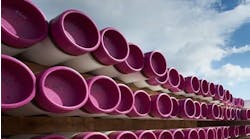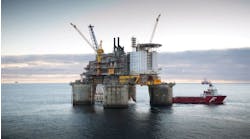Leonard LeBlanc
Houston
Learning to live with gas hydrates
How can producers deal with gas hydrates without paying a great deal for chemical or thermal inhibition or a pigging system. Many field capex projections can support installation of treatment systems, but the opex economic picture clouds over when the cost of chemicals or constant pigging must be taken into consideration.
The Gas Research Institute (GRI) has proposed what may be a more economic alternative - learn to live with the hydrates and develop a way to pump an equilibruim mixture through flowlines. Understanding the phase equilibrium where hydrates begin to form but do not yet agglomerate and attach to flowline walls is a key to pumping the mixtures. A combination of chemical and hydrodynamic controls could maintain pumpability of hydrates at lower cost than large volumes of chemicals now injected to defeat hydrate formation.
The GRI is conducting tests, along with the Deepstar Committee on Produced Fluids, the UK's Health and Safety Executive, and the Gas Processors Association to better understand hydrate blockages and the coating of flowlines to minimize that occurrence. A GRI study on how electrolytes influence the phase behavior of hydrates is due out in June of this year.
British Borneo will utilize Atlantia's Seastar minimum tension-leg platform for the development of Ewing Bank Blocks 921,964, and 965 (Morpeth discovery). The submerged three-leg system features a single column through the wave zone.
New technologies in field trials:
A number of new or revived drilling technologies were presented in a drilling contractors workshop sponsored by the Gas Research Insitute in Chicago recently:
- Casing vibration: Texaco is examining the effects of vibrating casing downhole to improve cement bonding and remove mud channels.
- High rate data downhole: Halliburton is testing a measurement-while-drilling tool capable of transmitting data at a rate of 30 bits/second in flow loops.
- Disk cutter bit: A drill bit consisting of disk cutters has been used for some years in mining and is being altered for oilfield use by Excavation Engineering Associations.
- Jet drilling: A new downhole pump to obtain the pressures needed for jet-assisted drilling has been developed by FlowDril. The firm is turning attention to nozzle erosion, the other major problem in this type of hole cutting.
Tatham salvages deepwater satellite
Paraffin accumulations have plagued Tatham Offshore's development of wells in the Ewing Banks area of the US Gulf of Mexico, but the operator may be putting those problems behind it. Oceaneering has installed bundled injection lines that will be used to used to dissolve accumulated paraffin deposits as well as inhibit the formation of new deposits. Paraffin forms in flowlines exposed to low deepwater temperatures as the crude oil leaves the wellhead.
Oceaneering designed, built, and installed a 36,000-ft long tri-line bundle consisting of a 3/8-in. line for solvent, a 3/8-in. line for inhibitor, and a spare 3/8-in. line. The bundle was laid from Tatham's satellite completion in Ewing Bank 914 to BP's Ewing Bank 826A platform.
Subsea hardware developed for the project included an ROV hot-stab manifold panel, umbilical clamps for the platform, and lead terminations. The installation was diverless.
Highlights of 1996 OTC program:
In addition to the special multi-papered sessions highlighted at the the 1996 Offshore Technology Conference in May, the technical sessions will deal with other interesting subjects:
- Method of shutting off and relining damaged tubing with on-site polymerization of wireline-run inflatable composite sleeve (Drillflex)
- Torque reductions up to 40% using a well radius section sub on extended reach wells (Security DBS)
- Fishing operations expert system to provide guidance for all downhole conditions (Petrobras)
- Three-leg tension leg platform with a low center-of-gravity, wave zone truss (Aker Omega)
- Ensuring that a drilling unit converted for production can last another 20 years (Petrobras)
- Hydrodynamic tests conducted on a cyclonic subsea separator (Petrobras)
- Using rejected noise from 3D seismic volumes and well logs to develop pore space content information (Geophysical Development)
- Use of 3D seismic to track fluid movement subsurface and mark drilling hazards (12 papers)
- Reassement and model testing of US Gulf platforms built in 1940s and 1950s (Mobil)
- Status of steel catenary risers and suitability for floating systems (MCS International)
- Design status of long-life, long-distance power, communication, and sparing umbilicals (Oceaneering Multiflex)
- Analysis of greenwater loading and impact on FPSO's equipment (MARIN)
- Field-wide deployment of subsea submersible pumps and wet-mateable electric connectors (Amoco Orient)
- Re-evaluation of decision-making supporting choice of dry or wet trees (Conoco)
- New fatigue and limit state data on jacket grouted tubular joints (MSL Engineering)
- Scheme for controlling severe slugging in pipeline risers (Total)
- Preliminary results of Deepstar's polyester taut leg mooring tests (Aker Marine)
- First insulated pipe-in-pipe reel-layed pipeline in the US Gulf (Global Pipelines)
- How under-inhibition is worse than no inhibition in hydrate control (Shell-Westport)
- Breakaway yield stress in re-starting flowlines with waxy crudes (Texaco EPTD)
- Pressurizing the annulus to extend coiled tubing reach in horizontal wells (Halliburton)
- Use of single-well seismic profiling to image salt flanks (Exxon PR)
- How weight/gravity balance above salt tongues explains salt movements (Lowrie et al)
- How gouging affects pipelines below iceberg scouring depth (SAIC)
- Hydrate formation during repair of a deepwater pipeline (Oman Oil)
- Simulation of a thick-wall pipeline collapse (Oman Oil)
Copyright 1996 Offshore. All Rights Reserved.




